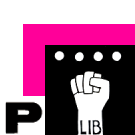User:Kim/reading/The Webs Grain: Difference between revisions
| Line 39: | Line 39: | ||
== Flux and Edgelessness == | == Flux and Edgelessness == | ||
* Chimero presentation "What screens want", what does it mean to natively design for screen? | * Chimero presentation "What screens want", what does it mean to natively design for screen? | ||
* he says <mark>flux – the capacity for things to change.</mark> | * he says <mark>flux – the capacity for things to change.</mark> – designing for web = managing change over time | ||
* and <mark>edgelessness</mark> – what I am not so sure about – there are edges we just dont often see them visually | * and <mark>edgelessness</mark> – what I am not so sure about – there are edges we just dont often see them visually | ||
* Chimero then states that on a practical level, working on websites also brings forth edgelessness of disciplines - maybe ideally but not yet! | * Chimero then states that on a practical level, working on websites also brings forth edgelessness of disciplines - maybe ideally but not yet! | ||
== Edgelessness in Interface Design == | == Edgelessness in Interface Design == | ||
Revision as of 13:16, 5 February 2025
Frank Chimero, 2015, https://frankchimero.com/blog/2015/the-webs-grain
some thoughts on the style of the text:
its very blog like, much and various media content (which I found annoying), no headlines or chapters, drawing arguments from various fields, starts his coclusions from the ground up
- begins with nostalgia (a strange opening, very striking, seeking for attention), then: things changed, stating his growing frustration and disappointment in tech and industry
- examines basic html structure - and challenges of responsive design (when you dont want page to be vertical)
- Bicycle Bear Websites Websites that do what they are not supposed to (going against their grain, their natural character) -- to what extend is that good or bad?
Every Material has a grain, including the web. [...] Too often the internet is cast as a wide-open, infinitely malleable material.
Web Interfaces
- brings some website interface design examples and reasons we use them
- flat colors/ gradients: lightweight, CSS
- horizontal stripes of content to level vertical bias
- ambient background images allow for cropping to unknown sizes
- mosaics present multitude of contents
We use text as interface, because the nuanced but significant differences in technology's abstractions are difficult to communicate visually.
- we share similar design solutions because we're using the same materials -- but still there is a creative industry that wants invention and one thing to be better than the other
What would happen if we stopped treating the web like a blank canvas to paint on, and instead like a material to build with?
David Hockney
- Hockney's 'The Scrabble Game' resemble designing for screen vs Mona Lisa stands for designing for print
- control vs discovery, uniformity vs multiplicity
challenges in web design:
an edgeless surface of unknown proportions comprised of small, individual, and variable elements from multiple vantages assembled into a readable whole that documents a moment
Flux and Edgelessness
- Chimero presentation "What screens want", what does it mean to natively design for screen?
- he says flux – the capacity for things to change. – designing for web = managing change over time
- and edgelessness – what I am not so sure about – there are edges we just dont often see them visually
- Chimero then states that on a practical level, working on websites also brings forth edgelessness of disciplines - maybe ideally but not yet!
Edgelessness in Interface Design
- In web design we dont have a fixed container size (like the printed page)
- so lets start with arrangements of content and then put them in different sizes
- ends the text with call to be cautious of too much convenience (in digital tech) because it limits agency
